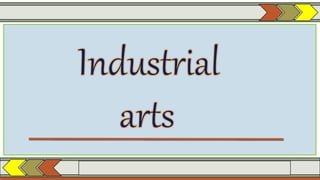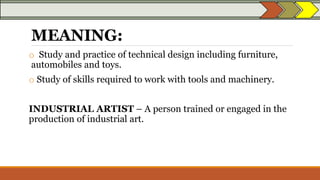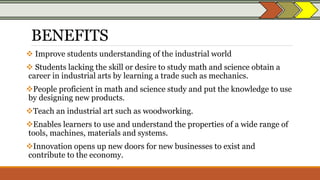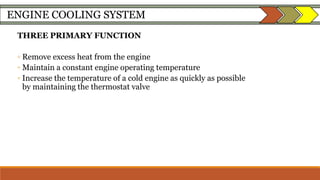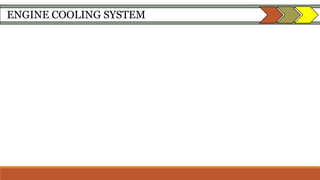INDUSTRIAL ARTS.pptx
- 1. AUTOMOTIVE
- 2. MEANING: o Study and practice of technical design including furniture, automobiles and toys. o Study of skills required to work with tools and machinery. INDUSTRIAL ARTIST – A person trained or engaged in the production of industrial art.
- 3. HISTORY PREHISTORIC TIMES – human beings first developed tools 1800 – Manual Training - formal instruction consisted of manual training for trades and manufacturing CALVIN WOODWARD – father of manual training. 1890 – Manual Arts (Russia) - concerned for creative design
- 4. 1900 – Industrial Arts (United States) - education became alternative for students seeking to learn a trade. Vocational school – teaching students specific skills such as automobile repair or furniture design Shop Class Greatest Nation in the World Today – Technology Education
- 5. PURPOSE For the students acquire an understanding of the industrial field in which man uses those material to improve his/her daily life. Contributes to the advancement of society. • technology
- 7. BENEFITS Improve students understanding of the industrial world Students lacking the skill or desire to study math and science obtain a career in industrial arts by learning a trade such as mechanics. People proficient in math and science study and put the knowledge to use by designing new products. Teach an industrial art such as woodworking. Enables learners to use and understand the properties of a wide range of tools, machines, materials and systems. Innovation opens up new doors for new businesses to exist and contribute to the economy.
- 8. AUTOMOTIVE
- 9. AUTOMOTIVE HISTORY Nicolas-Joseph Cugnot (1769) – first steamed-powered automobile capable of human transportation
- 10. STEAM ENGINE
- 11. AUTOMOTIVE HISTORY 1885 - Gottlieb Daimler invented the prototype of the modern gas engine — with a vertical cylinder, and with gasoline injected through a carburetor (patented in 1887). Daimler first built a two-wheeled vehicle the "Reitwagen" (Riding Carriage) with this engine and a year later built the world's first four-wheeled motor vehicle.
- 12. AUTOMOTIVE HISTORY 1886 - On January 29, Karl Benz received the first patent (DRP No. 37435) for a gas-fueled car.
- 13. AUTOMOTIVE HISTORY RECENT – Ford Model T created by Henry Ford, manufacturer of Ford Motor Company
- 14. PARTS OF AUTOMOBILE I. Chassis ◦ the frame or main structure of a vehicle ◦ contains all the major units necessary to propel the vehicle, guide its motion, stop it and allow it to run smoothly over uneven surfaces ◦ main mounting for all the components including the body. ◦ carrying unit.
- 15. PARTS OF AUTOMOBILE Automobile Body or Superstructure ◦ integral part of the chassis. ◦ made after receiving the chassis from the manufacturer ◦ The shape of the body depends upon the ultimate use for which the vehicle is meant. ◦ made of a sheet of metal or fibre glass, so that passengers can sit in it ◦ To make the journey comfortable, cushioned seats are provided ◦ The body is provided on all sides with glass panes fixed to protect the passengers from dust and rain.
- 16. PARTS OF AUTOMOBILE II. ENGINE complex unit in which different components are assembled together fuel is burned to produce power or energy The engine converts chemical energy (heat energy) into mechanical energy, whichis then utilized for vehicular movement. TWO TYPES OF ENGINE Internal Combustion (IC) engine - When the fuel is burned within the engine External Combustion (EC) engine - when it is burned externally and the produced steam is used for the mechanical movement
- 17. II. ENGINE PROCESS OF IGNITION SPARK IGNITION ENGINE combustion takes place by the spark generated by spark plug use petrol as fuel air-fuel mixture is inserted into the cylinder with the help of carburetor compression ignition engine Examples: scooters, motorcycles, cars
- 18. II. ENGINE PROCESS OF IGNITION COMPRESSION IGNITION ENGINE combustion takes place by the heat of the compressed air use diesel as fuel only air enters the cylinder during suction stroke using injector produces more hydrocarbons which lead to air pollution noise and vibration problem Examples: buses, trucks, ships
- 19. II. ENGINE The spark ignition engine can be differentiated from the compression ignition engine as per the following factors. The type of fuel used. The way the fuel enters in the combustion chamber. The way in which fuel is ignited.
- 21. PARTS OF AUTOMOBILE III. LUBRICATING SYSTEM •maintenance of engine. •The engine cannot run smoothly for more than a few minutes without the lubricating oil. •Whenever two metallic surfaces move over each other under direct contact, dry or solid friction is produced. This is due to the irregularities on the two surfaces interlocking each other. •The dry friction thus created produces a lot of heat and results in wear and tear of the metal surface.
- 22. ENGINE LUBRICATING SYSTEM PURPOSE OF LUBRICATING OIL The oil lubricates moving part to reduce friction. The oil reduces wear. The oil serves as a cooling agent. The oil helps to cushion the load. The oil reduces blow by In addition to lubricating the piston and rings. The oil acts as a cleaning agent.
- 23. ENGINE LUBRICATING SYSTEM OPERATION OF THE ENGINE LUBRICATING SYSTEM
- 25. ENGINE COOLING SYSTEM THREE PRIMARY FUNCTION ◦ Remove excess heat from the engine ◦ Maintain a constant engine operating temperature ◦ Increase the temperature of a cold engine as quickly as possible by maintaining the thermostat valve
- 26. ENGINE COOLING SYSTEM NECEESSITY OF COOLING The cylinders of internal combustion engines require cooling because the engine cannot convert all the heat energy released by combustion into useful work. Liquid cooling is employed in most of the IC engines, whether they are used in automobiles or elsewhere. The water (coolant) is circulated around the cylinders to pick up heat and then dissipate it through a radiator. As the temperature increases from 71 to 82 degrees centigrade, the thermostat valve opens and sends water to the radiator to radiate the heat. When the temperature rises above 82 degrees, the thermostat switch operates the cooling fan to support the cooling process in radiator.
- 28. AUTOMOTIVE QUIZ
